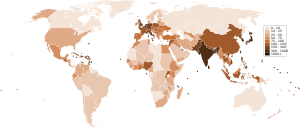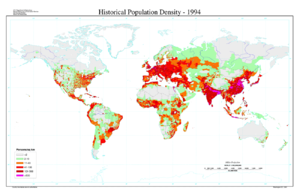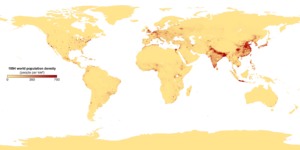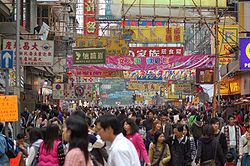- Population density
-
Population density (in agriculture standing stock and standing crop) is a measurement of population per unit area or unit volume. It is frequently applied to living organisms, and particularly to humans. It is a key geographic term.[1]
Contents
Biological population densities
Population density is population divided by total land area.[1]
Low densities may cause an extinction vortex and lead to further reduced fertility. This is called the Allee effect after the scientist who identified it. Examples of the causes in low population densities include:[2]
- Increased problems with locating mates
- Increased inbreeding
Different species have different expected densities. R-selected species commonly have high population densities, while K-selected species may have lower densities.[3] Low densities may be associated with specialized mate location adaptations such as specialized pollinators, as found in the orchid family (Orchidaceae).
Human population density
For humans, population density is the number of people per unit of area usually per square kilometer or mile (which may include or exclude cultivated or potentially productive area). Commonly this may be calculated for a county, city, country, another territory, or the entire world.
The world's population is 7 billion,[4] and Earth's total area (including land and water) is 510 million square kilometers (197 million square miles).[5] Therefore the worldwide human population density is 6.8 billion ÷ 510 million = 13.3 per km² (34.5 per sq. mile). If only the Earth's land area of 150 million km² (58 million sq. miles) is taken into account, then human population density increases to 45.3 per km² (117.2 per sq. mile). This calculation includes all continental and island land area, including Antarctica. If Antarctica is also excluded, then population density rises to 50 people per km² (129.28 per sq. mile).[1] Considering that over half of the Earth's land mass consists of areas inhospitable to human inhabitation, such as deserts and high mountains, and that population tends to cluster around seaports and fresh water sources, this number by itself does not give any meaningful measurement of human population density.
Several of the most densely-populated territories in the world are city-states, microstates, micronations, or dependencies.[6][7] These territories share a relatively small area and a high urbanization level, with an economically specialized city population drawing also on rural resources outside the area, illustrating the difference between high population density and overpopulation.
Cities with high population densities are, by some, considered to be overpopulated, though the extent to which this is the case depends on factors like quality of housing and infrastructure and access to resources.[8] Most of the most densely-populated cities are in southern and eastern Asia, though Cairo and Lagos in Africa also fall into this category.[9]
City population is, however, heavily dependent on the definition of "urban area" used: densities are often higher for the central municipality itself, than when more recently-developed and administratively separate suburban communities are included, as in the concepts of agglomeration or metropolitan area, the latter including sometimes neighboring cities. For instance, Milwaukee has a greater population density when just the inner city is measured, and not the surrounding suburbs as well.[10]
As a comparison, based on a world population of seven billion, the world's inhabitants would, as a loose crowd taking up ten square feet per person (Jacobs Method), would occupy a space roughly the size of Fiji's land area.
Other methods of measurement
While arithmetic density is the most common way of measuring population density, several other methods have been developed which aim to provide a more accurate measure of population density over a specific area.
- Arithmetic density: The total number of people / area of land (measured in km² or sq miles).
- Physiological density: The total population / area of arable land.
- Agricultural density: The total rural population / area of arable land.
- Residential density : The number of people living in an urban area / area of residential land.
- Urban density : The number of people inhabiting an urban area / total area of urban land.
- Ecological optimum: The density of population which can be supported by the natural resources.
See also
- Human geography
- Idealized population
- Optimum population
- Population bottleneck
- Population genetics
- Population health
- Population momentum
- Population pyramid
- Rural transport problem
- Small population size
Lists:
- List of cities by population
- List of cities by population density
- List of European cities proper by population density
- List of islands by population density
- List of countries by population density
- List of U.S. states by population density
References
- ^ a b c About.com
- ^ Minimum viable population size
- ^ Density-Dependent Selection
- ^ [1]
- ^ [2]
- ^ Department of Economic and Social Affairs Population Division (2009) (.PDF). World Population Prospects, Table A.1. 2008 revision. United Nations. http://www.un.org/esa/population/publications/wpp2008/wpp2008_text_tables.pdf. Retrieved 2009-03-12.
- ^ The Monaco government uses a smaller surface area figure resulting in a population density of 18,078 per km2
- ^ Human Population - Global Issues
- ^ The largest cities in the world by land area, population and density
- ^ The Population of Milwaukee County
External links
Topics on human population Major articles World population · Family planning · Green revolution · Overpopulation · Over-consumption (water crisis) · Reproductive rights · Sustainable developmentBiological topics Population biology · Population control (one-child policy · Immigration reduction) · Population decline · Population density (physiological density) · Population growth · Population pyramidPopulation ecology Carrying capacity · Ecological footprint · I = P • A • T · Malthusian growth model · World3 model · Food security · World energy consumption · World energy resources · Habitat destruction · Optimum populationLiterary works Lists Most highly populated countries · Metropolitan areas by populationEvents and
organizationsRelated articles World Population Day · "The Day of Five Billion" · "The Day of Six Billion" · "Day of Seven Billion" · "Ecological Debt Day" · Easter Island downfall · Classic Maya collapse · Holocene extinction · Fertility and intelligence
Wikimedia Foundation. 2010.





